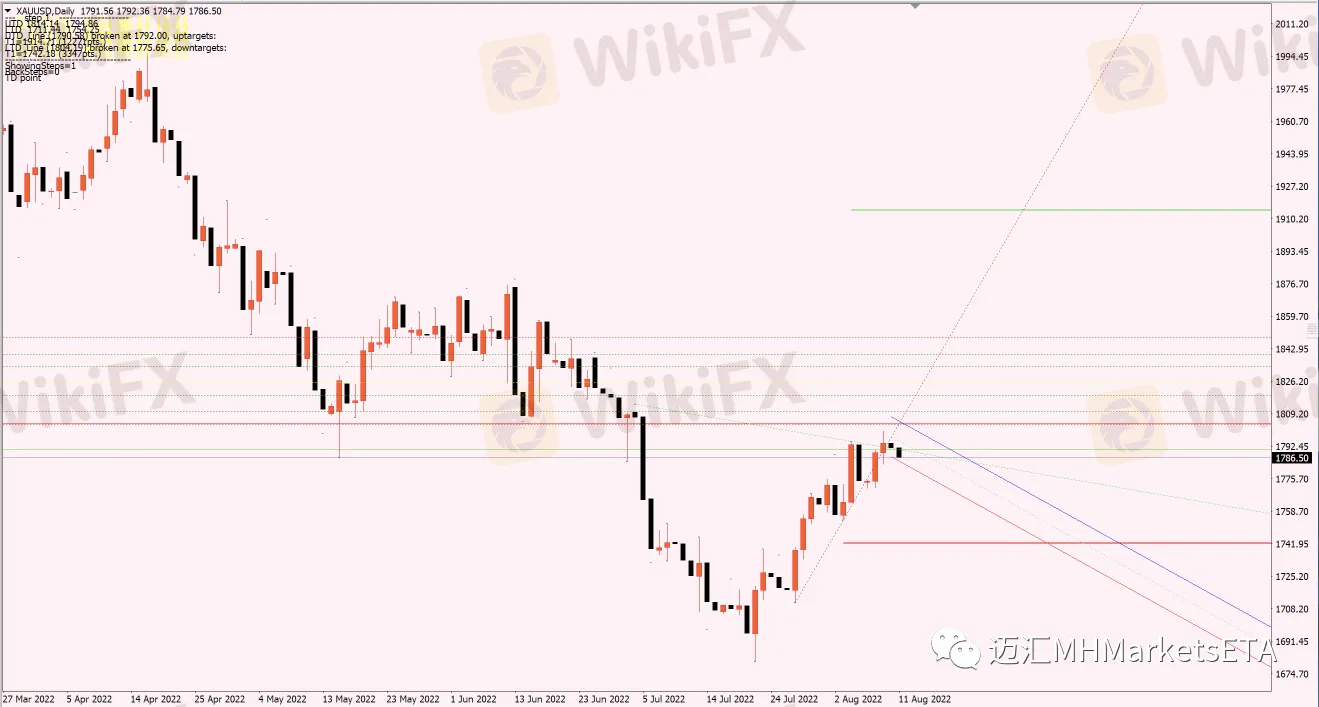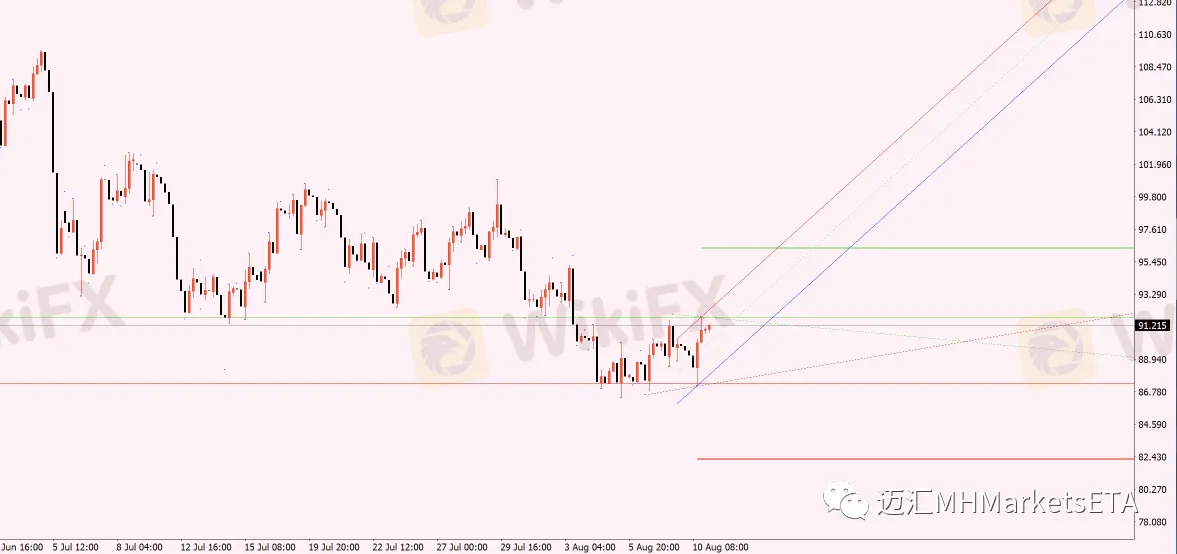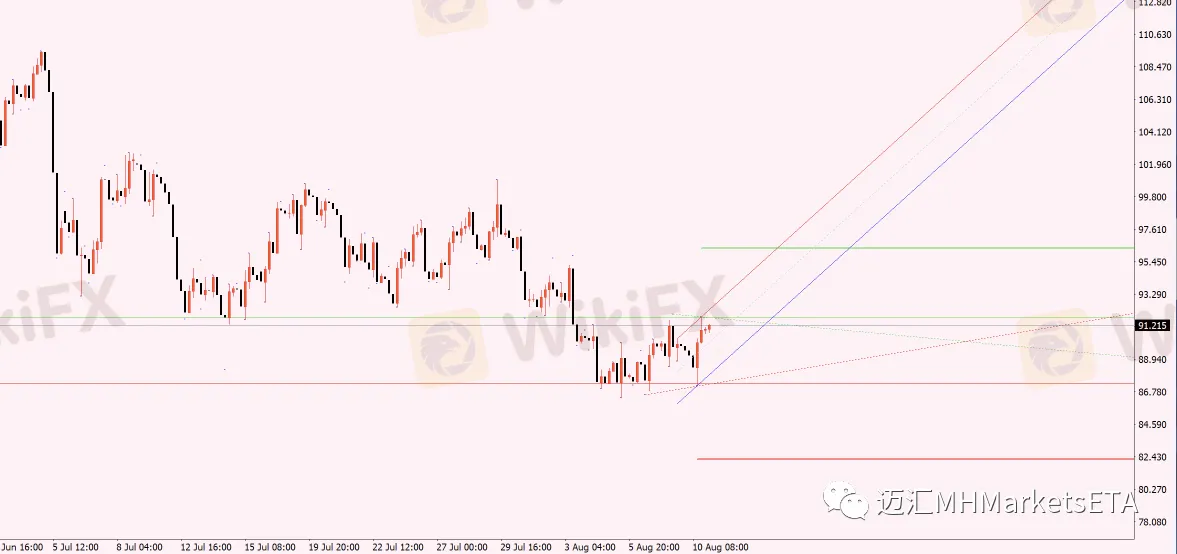Mohicans markets :U.S. Inflation Slows More Than Expected Foucs On PPI Data And Initial Requisition Data
Zusammenfassung:On Wednesday, August 10, spot gold rose and fell, broke through but failed to stabilize at the US$1,800 mark, and finally closed down 0.12% at US$1,792.04 per ounce; spot silver pared some of its gains and finally closed up 0.37% at $20.6 per ounce. In terms of the two oils, WTI crude oil fell first and then rose, recovering all the lost ground in the day, and finally closed up 1.07% at US$91.56 per barrel. Brent crude oil closed up 0.72% at US$96.99 per barrel.

Financial Events Today
Risk Warning:
☆ 16:00 The International Energy Agency will release the monthly crude oil market report. Investors can follow the IEA's expectations on the supply and demand of the crude oil market and the future trend of oil prices from the report.
☆ OPEC will also release its monthly crude oil market report within days. Although OPEC+ crude output rose by the most in five months in July, OPEC+ has struggled to even maintain output, according to a recent Platts survey by S&P Global Commodity Insights. The gap between OPEC+s output and its quota widened to 2.8 million bpd, and OPEC+ compliance with production cuts soared to a record high of 222.9 percent this month.
☆ 20:30 The number of initial jobless claims for the week from the United States to August 6 will be announced, and the market is expected to be 264,000, while the previous value was 260,000, which is close to the highest level since November.
☆ 20:30 US PPI monthly rate will be announced. Market expectations were 0.2%, the previous value of 1.1%.
Global Views - List of Major Markets
On Wednesday, August 10, spot gold rose and fell, broke through but failed to stabilize at the US$1,800 mark, and finally closed down 0.12% at US$1,792.04 per ounce; spot silver pared some of its gains and finally closed up 0.37% at $20.6 per ounce.
In terms of the two oils, WTI crude oil fell first and then rose, recovering all the lost ground in the day, and finally closed up 1.07% at US$91.56 per barrel. Brent crude oil closed up 0.72% at US$96.99 per barrel.
Affected by the lower-than-expected U.S. CPI data in July, the U.S. dollar index plunged in the U.S. market, falling below the 105 mark at one point, then recovered upwards, and finally closed down 1.006% at 105.25.
The three major U.S. stock indexes opened higher and closed sharply higher. The Dow closed up 1.63%, the Nasdaq closed up 2.89%, and the S&P 500 closed up 2.13%. Star technology stocks rose across the board, with Netflix up about 6%, Amazon up about 3%, and Apple up about 2%.The Nasdaq Composite entered a technical bull market with a 20% gain from its June low.
European stocks closed at the close, with Germany's DAX up 1.23%, the UK's FTSE 100 up 0.25%, France's CAC40 up 0.25%, and the European Stoxx 50 up 0.91%.
Precious Metal
In early trading on Thursday, August 11, gold prices played down gains due to U.S. inflation as gold prices fell back to around $1,790. The latest weakness in the precious metals could be related to mixed concerns around the Fed's next move and U.S.-China tensions.

On this trading day, pay attention to the annual U.S. PPI data in July and the number of initial jobless claims for the week ended August 6 in the United States.
Crude
In early trading on Thursday, August 11, U.S. oil traded around $91.40 a barrel. Oil prices rebounded from early losses on Wednesday and rose more than 1%, helped by encouraging U.S. gasoline demand data. At the same time, lower-than-expected inflation data in the United States also boosted oil prices. In addition, the risk of energy supply in Europe in winter is approaching, and oil prices have further upside potential.

Bullish Factors Affecting Oil Prices
[U.S. gasoline inventories fell sharply to boost oil prices]
[U.S. consumer prices were flat in July, and there were early signs of a clear slowdown in inflation]
[Winter supply risks looming, European natural gas prices rebound]
[The fire at the Cuban oil storage base has not been fully controlled]
Negative Factors Affecting Oil Prices
[North Asian buyers will receive Saudi Aramco's full supply of crude oil according to the contract quantity in September]
[Russia has resumed oil shipments to Hungary and Slovakia through Ukraine]
[Japan's new confirmed cases of COVID-19 exceed 250,000 for the first time in a single day]
On the whole, the Druzhba pipeline from Russia to Europe has resumed oil delivery, and supply concerns have subsided. Gasoline inventories in the United States have fallen sharply, while demand has rebounded, and U.S. inflation has clearly slowed down. Pay attention to the IEA monthly report and the OPEC monthly report during the day.
Foreign Exchange
In early trading on Thursday, August 11, the U.S. dollar index fluctuated within a narrow range and is currently trading around 105.21, close to the 55-day moving average, slightly higher than the more than one-month low of 104.63 set overnight. Wednesday's data showed that U.S. inflation fell in July. The rate of slowdown exceeded expectations, which boosted expectations that the Feds current rate hike cycle was not as aggressive as previously expected. The U.S. dollar index weakened sharply, hitting a new low of 104.63 since July 1. However, it rebounded slightly in late trading, as Fed officials continued to make hawkish speeches and closed at 105.23, down about 1.02%. Other non-US currencies generally rose.

The U.S. Consumer Price Index was flat month-on-month in July as gasoline costs fell sharply, the first sign that inflation has eased significantly for Americans who have watched inflation climb over the past two years. Economists polled had forecast CPI would rise 0.2% in July from the previous month amid a roughly 20% drop in gasoline costs. The dollar fell 1.68% against the yen on Wednesday to close at 132.86, after falling as much as 2.3% during the session, hitting a one-week low of 132.03, the biggest drop since March 2020. The euro against the dollar hit a new high of 1.0368 since July 6 on Wednesday, and closed up 0.84% to close at 1.0298 and the pound against the dollar closed up 1.16% against the dollar on Wednesday to 1.2212, and both currencies recorded their best single-day performance since mid-June. However, the euro is also currently being suppressed by resistance near the 55-day moving average at 1.0370. The Australian dollar, which is regarded as a risk barometer, rose 1.68% to close at 0.7078 on Wednesday, also recording the largest one-day increase since mid-June. The Australian dollar once hit a new high of 0.7108 in the past two months, currently trading around 0.7081, slightly below the 100-day moving average of 0.7085. The New Zealand dollar against the US dollar closed up 1.88% on Wednesday to close at 0.6402. The intraday high had hit 0.6433, the highest since June 13, and the top concern was around the 100-day moving average of 0.6439.
International News
1. United Nations: Efforts are being made to speed up grain transportation in Ukraine On August 10, local time, Frederick Kenney, interim coordinator of the United Nations Joint Coordination Center of the Black Sea Grains Initiative, said that since the establishment of the Joint Coordination Center, it has successfully a safe navigation channel for grain shipments from Ukrainian ports has been established, and detailed grain shipment procedures have been formulated. Kenney said that since the Black Sea Grains Initiative was reached, 12 grain ships have been permitted to leave Ukrainian ports, and 4 grain ships have been permitted to enter Ukraine to load cargoes, and about 300,000 tons of grains have been transported so far. (CCTV News)
2. U.S. CPI data for July was lower than expected, and cooling inflation eased pressure on the Fed to continue aggressive rate hikes, with investors now pricing in a greater chance of a 50 basis point rate hike next month rather than 75 basis points. But the Fed had previously said it would need to see months of declines in the CPI before slowing its aggressive monetary policy.
3. Chicago Fed President Evans said U.S. inflation was “unacceptably high.” Evans expects the federal funds rate to be in the 3.75%-4% range by the end of 2023. Evans said the Fed could shift to a more hawkish stance if needed.
4. Minneapolis Fed President Kashkari said the July CPI will not change his view, and he wants the Fed to raise its benchmark interest rate to 3.9% by the end of this year and 4.4% by the end of 2023. Kashkari said the Fed is more likely to raise the federal funds rate to a certain level and wait until it is confident that inflation has returned to 2% before considering a rate cut.
5. Data released by the U.S. Energy Information Administration on August 10 showed that U.S. crude oil production reached 12.2 million barrels per day, the highest since April 2020. In addition, U.S. crude oil inventories increased by 5.46 million barrels last week, and U.S. crude oil exports fell by 1.402 million barrels per day to 2.110 million barrels per day last week.
6. Ukraine has confirmed receipt of transit payments, and Rosneft has resumed oil shipments on the southern route via the Friendship pipeline.
7. The 120-day “transition period” set by the EU on banning the import of Russian coal will end at midnight on the 10th, and the EU's embargo on Russian coal will officially take effect.
8. Due to the impact of high temperature and drought, the water level of the Rhine River has dropped significantly. It is expected that the key position on August 12 will be almost impassable, and the major shipping arteries in Europe are facing the crisis of suspension of navigation.
9. Euro zone money markets are now fully pricing in a 50 basis point rate hike by the European Central Bank in September.
10. Britain's military intelligence agency said it was almost certain that Russia had created a major new ground force formation, the Third Army, to support operations in Ukraine. Ukrainian President Volodymyr Zelensky said Ukraine needs to consider how to inflict as much damage on Russia as possible to shorten the conflict.
11. Market sources said Iraq set the official selling price of Basra Intermediate crude for September to Asia at a premium of $5.10 per barrel to the average Oman/Dubai price.
12. Japan added 250,379 new confirmed cases of new COVID-19, surpassing 250,000 for the first time.
13. Winter supply risks loom, European gas prices recover on Wednesday, European gas prices rose after three straight sessions of losses.
14. British long-term fund Bamerle Gifford almost sold off Alibaba in Q2.
Institutional Currency Viewpoint
[Bridgewater Fund founder Ray Dalio: The bull market factor in US stocks is reversing]
[Bank of New York Mellon: Seeking refuge in short-term bonds has become a global phenomenon]
[Goldman Sachs lowers spot gold and silver price expectations]
[III Capital Management:Fed needs more evidence of slowing inflation]
[High Frequency Economic: Still adhere to the Feds expectation of a 75 basis point rate hike in September]
Statement | Disclaimer
Disclaimer: The information contained in this material is for general advice only. It does not take into account your investment goals, financial situation or special needs. Mohicans Markets has made every effort to ensure the accuracy of the information as of the date of publication. Mohicans Markets makes no warranties or representations regarding this material. The examples in this material are for illustration only. To the extent permitted by law, Mohicans Markets and its employees shall not be liable for any loss or damage arising in any way, including negligence, from any information provided or omitted from this material.The features of Mohicans Markets products, including applicable fees and charges, are outlined in the product disclosure statements available on the Mohicans Markets website and should be considered before deciding to deal with these products. Derivatives can be risky and losses can exceed your initial payment. Mohicans Markets recommends that you seek independent advice.
MohicansMarkets, (Abbreviation: MHMarkets or MHM, Chinese name: Mai hui), Australian Financial Services License No. 001296777.

WikiFX-Broker
Aktuelle Nachrichten
Japanischer Yen hat Schwierigkeiten, bescheidene Gewinne gegenüber dem USD aufgrund von Tarifängsten zu nutzen
Sensations-Startup Loveable: Nimmt die KI uns jetzt wirklich die Jobs weg?
Longevity: Wie Florian Meissner sein Bluttest-Startup skalieren will — und welche Rolle der Gorillas-Gründer dabei spielt
Australischer Dollar steigt, während der US-Dollar vor dem ISM Manufacturing PMI gedämpft bleibt
Sensations-Startup Loveable: Nimmt die KI uns jetzt schon die Jobs weg?
Bitcoin springt auf mehr als 93.000 US-Dollar – das ist der Grund
Wechselkursberechnung


